Fiber optic cables have become the backbone of modern telecommunications, revolutionizing the way we communicate. With their ability to transmit signals at the speed of light, these cables offer high bandwidth and long-distance transmission capabilities.
In an era where data consumption is continuously growing, fiber optic cables have proven to be the preferred choice due to their immunity to electromagnetic interference and their capacity to handle large volumes of data.
This article will explore the crucial role of fiber optic cables in the telecom industry, discussing their various types, benefits, installation process, and the factors affecting their performance. Understanding the intricacies of fiber optic cable infrastructure is essential for anyone seeking to comprehend the foundation of modern telecommunications.
Key Takeaways
- Fiber optic cables revolutionize communication by providing high bandwidth and long-distance transmission capabilities.
- They are the backbone of the internet, enabling the transmission of voice, video, and telemetry signals.
- Fiber optic cables offer unmatched speeds of data transmission and enhanced reliability and security.
- They are immune to electromagnetic interference and are ideal for transmitting sensitive information over long distances.
Role of Fiber Optic Cables in Telecom
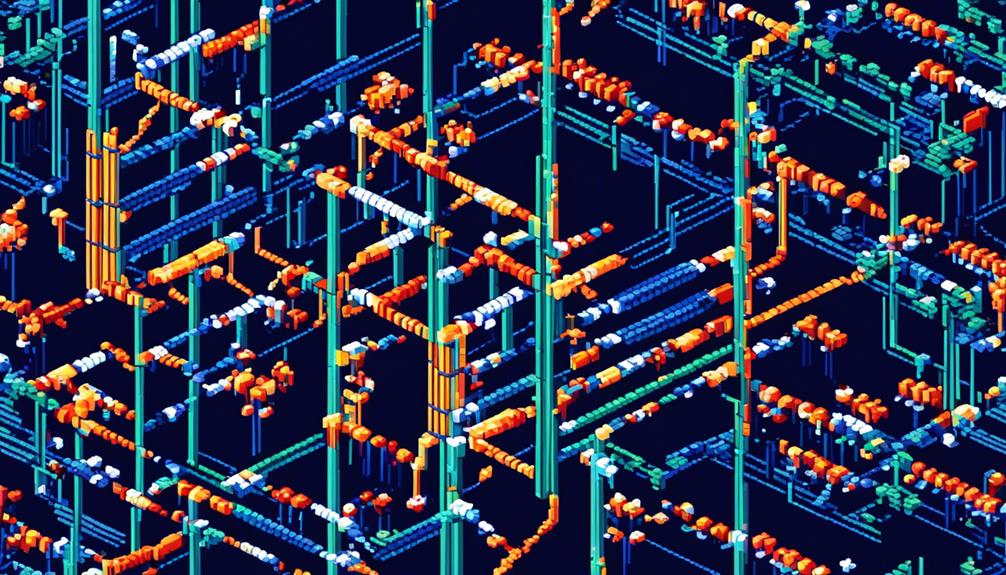
Fiber optic cables play a pivotal role in the telecommunications industry, revolutionizing the way information is transmitted with their high bandwidth, long-distance capabilities, and immunity to electromagnetic interference. These cables, made of thin strands of optically pure glass, have largely replaced copper wire in backbone networks since their introduction in the 1970s.
The advantages of fiber optic technology are numerous. Firstly, fiber optic cables offer high bandwidth, allowing for the transmission of large amounts of data at incredible speeds. This makes them ideal for applications such as internet connectivity, where fast and reliable data transfer is crucial. Additionally, fiber optic cables have the ability to transmit signals over long distances without any degradation in quality. This makes them suitable for long-haul telecommunications networks, connecting different cities or even continents.
Another significant advantage of fiber optic cables is their immunity to electromagnetic interference. Unlike traditional copper cables, which can suffer from signal degradation due to electromagnetic interference, fiber optic cables are not affected by such external factors. This ensures that the data being transmitted remains intact and reliable.
The role of fiber optic cables in the telecommunications industry cannot be overstated. They are the backbone of the internet, carrying vast amounts of data across the globe. Without fiber optic cables, the modern digital age would not be possible. These cables enable the transmission of voice, video, and telemetry signals over local area networks or long distances, providing the infrastructure needed for our interconnected world.
Types of Fiber Optic Cables
There are various types of fiber optic cables available, each designed to meet specific requirements in telecommunications and other industries.
Two common types of fiber optic cables are single-mode and multi-mode cables. Single-mode fibers have smaller core diameters and are optimal for long-distance, high-bandwidth applications in telecommunications. They offer a higher bandwidth and a longer transmission distance compared to multi-mode fibers. Single-mode cables are widely used in telecommunications networks for transmitting voice, video, and data over long distances.
On the other hand, multi-mode fibers have larger core diameters and are cost-effective for shorter distances required in enterprise and data center networks. They are suitable for applications that do not require long transmission distances or high bandwidth. Multi-mode cables are commonly used in local area networks (LANs) and shorter distance communication systems.
Fiber optic cables can also be categorized as simplex or duplex cables. Simplex cables contain a single strand of glass and are used for applications that require one-way communication. Duplex cables, on the other hand, consist of two strands of fiber optic cables and are used for duplex communication.
Additionally, there are plenum cables that are specifically designed to comply with industry standards for installation in air plenums. These cables are suitable for various applications in telecommunications, broadcasting, and computer networking.
Benefits of Fiber Optic Cables in Telecommunications

Fiber optic cables provide numerous benefits in telecommunications.
Firstly, they offer lightning-fast speeds and increased bandwidth capabilities, ensuring high-speed data transmissions.
Secondly, these cables are reliable and secure, as they are immune to electromagnetic interference and difficult to intercept.
Lastly, fiber optic cables enable long-distance transmission, making them essential for global business connectivity and the expansion of internet usage.
Speed and Bandwidth
With lightning-fast speeds and a significantly increased bandwidth, fiber optic cables offer unparalleled advantages in the field of telecommunications. Here are three reasons why fiber optic cables excel in terms of speed and bandwidth:
- Optimal Speeds: Unlike copper cables that transmit data through electrical signals, fiber optic cables use optical fibers made of glass or plastic to transmit data using light signals. This allows for data to be transmitted at the speed of light, resulting in ultra-fast communication.
- Increased Bandwidth: Fiber optic cables have a larger core compared to copper cables, allowing for a higher capacity to carry data. This increased bandwidth enables the simultaneous transfer of large amounts of data, making it ideal for applications that require high-speed and high-volume data transmission.
- Minimal Signal Loss: Optical fibers used in fiber optic cables have a low attenuation rate, meaning that the signal loss during transmission is minimal. This ensures reliable and efficient data transmission over longer distances without degradation.
Reliable and Secure
Reliable and secure, fiber optic cables provide a robust and dependable solution for transmitting data in the field of telecommunications. With lightning-fast speeds and long-distance transmission capabilities, fiber optic cables are ideal for high-speed data transmissions and global connectivity.
Their immunity to electromagnetic interference ensures reliable and secure data transmission, making them crucial for businesses reliant on a consistent internet connection.
Additionally, fiber optic cables offer increased bandwidth, allowing for the simultaneous transmission of large volumes of data in both directions. Enhanced security is another key benefit of fiber optic cables, as their signals are difficult to intercept without physically cutting into the cable.
Long Distance Transmission
Long distance transmission is a key advantage of fiber optic cables in the field of telecommunications, enabling high-speed and secure data transmission over vast distances. Here are three key benefits of fiber optic cables for long distance transmission:
- Enhanced data transfer speeds: Fiber optic cables use optical fibers that transmit data using light signals. This technology allows for significantly higher data transfer speeds compared to traditional copper wiring. With fiber optic cables, telecom companies can transmit large amounts of data quickly and efficiently.
- Increased bandwidth: Fiber optic cables offer a much larger bandwidth capacity compared to other transmission mediums. This means that more data can be transmitted simultaneously, allowing for seamless communication and faster downloads and uploads.
- Reliable and secure transmission: Unlike copper wiring, fiber optic cables are immune to electromagnetic interference. This makes them more reliable for long distance transmission, ensuring that the data arrives intact and without any loss or degradation. Additionally, the secure nature of fiber optic cables makes them ideal for transmitting sensitive information over long distances.
Fiber Optic Cable Installation Process
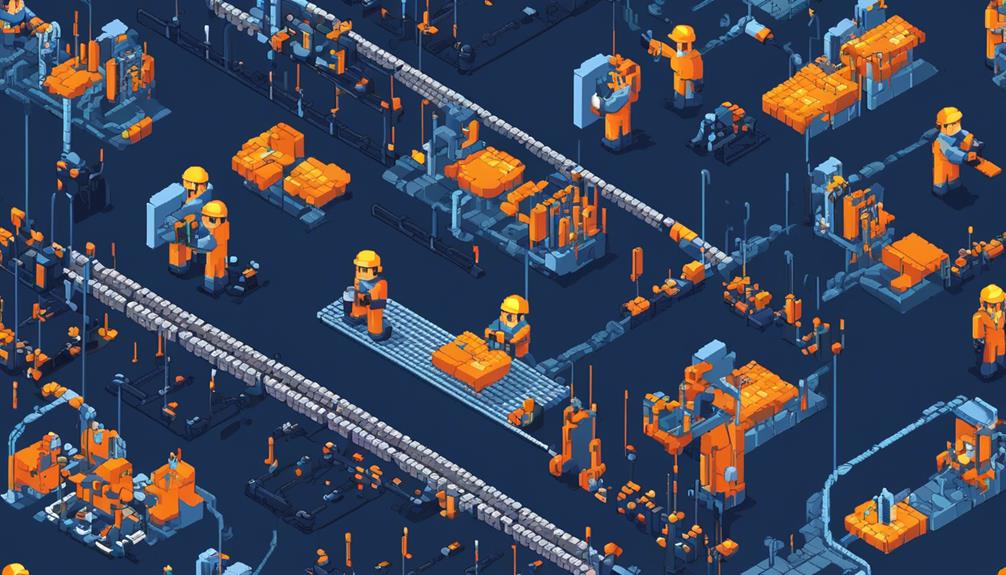
The installation process of fiber optic cables involves meticulous planning, careful pathway preparation, and thorough assessment of environmental factors to ensure efficient and reliable connectivity.
Telecom companies rely on fiber optic cables for their high-speed transmission capabilities and numerous advantages over traditional copper cables.
The installation process begins with planning the route for the fiber optic cable. This includes determining the best pathway, avoiding obstacles and potential hazards, and obtaining any necessary permits. Proper pathway preparation ensures the cable's protection from external elements and interference, such as electromagnetic fields and moisture.
Once the pathway is prepared, the actual installation process begins. This can involve trenching or plowing the cable underground, pulling the cable through conduits, or aerially suspending the cable. The installation method depends on the specific requirements of the telecom network.
During installation, it is crucial to handle the fiber optic cable carefully to prevent damage to the delicate strands. Proper testing of the cable is also essential to ensure that it meets industry standards and can provide the desired speed and performance.
Adherence to industry standards and regulations is paramount during the installation process. This ensures safety, quality assurance, and compatibility with existing infrastructure.
After installation, thorough documentation and testing of the fiber optic network are necessary. This documentation aids in troubleshooting and maintenance, allowing for efficient repairs or upgrades as needed.
Importance of Fiber Optic Cables in Modern Telecommunications
With their lightning-fast speeds and enhanced security, fiber optic cables have become indispensable in modern telecommunications, revolutionizing global connectivity and paving the way for the future of internet usage and IoT devices.
Here are three reasons why fiber optic cables are of utmost importance in modern telecommunications:
- Unmatched Speeds: Fiber optic cables enable data transmission at the speed of light, providing significantly faster speeds compared to traditional copper wiring. This high-speed transmission allows for seamless communication and real-time data transfer, essential for applications such as video conferencing, online gaming, and cloud computing.
- Enhanced Data Transmission: Fiber optic cables offer a much higher bandwidth compared to copper cables, allowing for the transmission of large amounts of data simultaneously. This increased capacity supports the growing demand for internet access and enables the smooth delivery of high-definition videos, audio files, and other data-intensive applications.
- Improved Reliability and Security: Unlike copper cables, fiber optic cables are immune to electromagnetic interference and signal degradation. This makes them highly reliable, ensuring consistent data transmission without any loss or distortion. Additionally, fiber optic technology provides enhanced security as it is difficult to tap or intercept the light signals traveling through the cables, making it ideal for transmitting sensitive information over long distances.
Fiber Optic Cable Maintenance and Upkeep
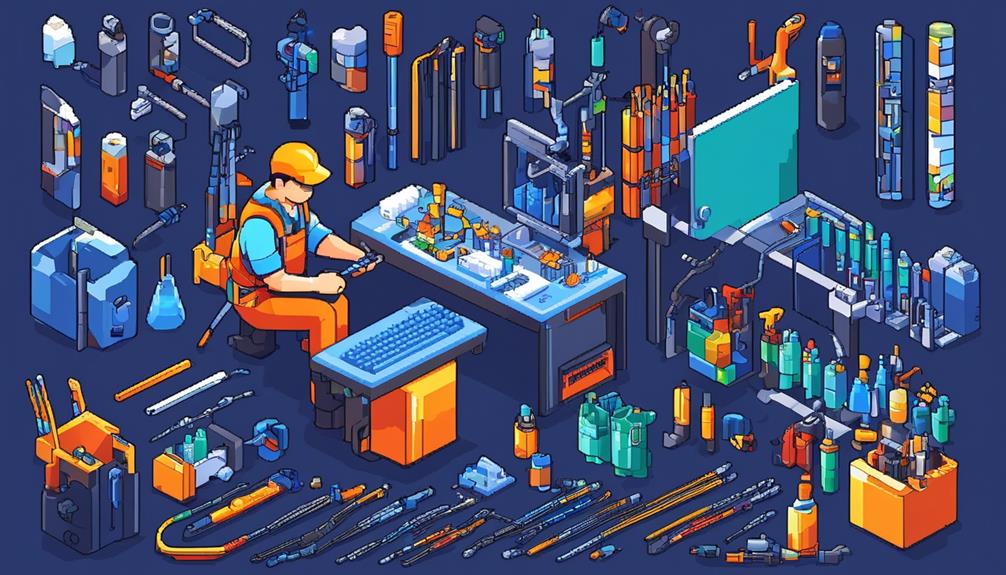
Maintaining the optimal performance and longevity of fiber optic cables requires diligent and proactive upkeep measures. Fiber optic cables, which consist of multi-mode optical fibers or single mode fibers, offer numerous advantages over traditional copper cables, such as higher speeds and greater bandwidth capacity. However, to ensure the continued reliability and efficiency of fiber optic networks, regular maintenance and upkeep are essential.
One important aspect of fiber optic cable maintenance is conducting regular visual inspections. This involves checking for any signs of wear, damage, or bending, which can compromise the integrity of the cables. Additionally, it is crucial to keep fiber optic connectors clean and free from dust, oil, or any other contaminants. This helps to maintain signal integrity and prevent signal loss.
Proper cable management techniques are also critical in fiber optic cable upkeep. Excessive bending, stretching, or pulling of the cables can lead to signal degradation or cable damage. Therefore, it is necessary to implement appropriate cable management practices to avoid these issues.
To proactively monitor and test fiber optic cables, optical time-domain reflectometer (OTDR) equipment can be utilized. This equipment helps to identify any potential issues or faults in the network, allowing for timely maintenance and repairs.
Establishing a comprehensive maintenance schedule is vital in maintaining fiber optic cables. This includes routine cleaning, testing, and documentation of any maintenance activities performed. By following a regular maintenance routine, the performance and longevity of fiber optic cables can be maximized.
In summary, fiber optic cable maintenance and upkeep are crucial for ensuring the optimal performance and longevity of these cables. Regular visual inspections, proper cleaning and cable management, proactive monitoring and testing, and a comprehensive maintenance schedule are all essential aspects of fiber optic cable upkeep. By implementing these measures, organizations can maintain the efficiency and reliability of their fiber optic networks.
| Maintenance Measure | Description | Importance |
|---|---|---|
| Visual Inspections | Regularly checking for wear, damage, and bending in fiber optic cables | Ensures cable integrity and identifies potential issues |
| Connector Cleaning | Keeping fiber optic connectors clean and free from contaminants | Maintains signal integrity and prevents signal loss |
| Cable Management | Implementing proper techniques to avoid excessive bending, stretching, or pulling of fiber optic cables | Prevents signal degradation and cable damage |
| Proactive Monitoring | Utilizing OTDR equipment to monitor and identify potential issues or faults in the network | Allows for timely maintenance and repairs |
| Comprehensive Schedule | Establishing a routine maintenance schedule that includes cleaning, testing, and documentation of maintenance activities | Maximizes performance and longevity of fiber optic cables |
Fiber Optic Cable Testing and Troubleshooting
Fiber optic cable testing and troubleshooting are essential for maintaining the reliability and performance of telecom networks. Testing methods, such as using an optical time domain reflectometer (OTDR) and visual inspection, help identify signal loss, faults, physical damage, and contamination.
Accurate measurements and common troubleshooting techniques ensure proper signal strength and connectivity, minimizing downtime and optimizing network efficiency.
Testing Methods for Fiber Optics
To ensure the reliability and performance of fiber optic cables in the telecommunications industry, various testing methods are employed. These testing methods play a crucial role in maintaining the quality of communication between devices and ensuring that the fiber optic cables function as an efficient transmission medium for optical signals.
The three main testing methods used for fiber optics are:
- Optical Time-Domain Reflectometry (OTDR): This method measures signal loss and identifies faults in the fiber optic cable. It does so by sending a series of light pulses and analyzing the reflections.
- Visual Inspection: Technicians visually examine the connectors and end faces of fiber optic cables. This is done to check for dirt, damage, or defects that could affect the performance.
- Power Meter Testing: This method uses a power meter to measure the amount of light transmitted through the cable. It is used to check for signal strength.
Common Troubleshooting Techniques
In order to effectively troubleshoot fiber optic cables and address any potential issues, a range of common troubleshooting techniques are utilized in the telecommunications industry.
These techniques include Optical Time Domain Reflectometer (OTDR) testing, which analyzes the backscattered light to identify any breaks, bends, or connection issues in the fiber optic cable.
Visual Fault Locator (VFL) testing uses a laser diode to visually inspect the cable for breaks, macrobends, and poor splices.
Power meter testing measures the optical power in the cable to identify any power losses or irregularities, helping to locate faulty connectors or splices.
Continuity testing ensures an uninterrupted signal path, detecting any breaks or faults.
Insertion Loss testing measures the loss of signal strength, identifying excessive losses due to faulty connectors or splices.
These troubleshooting techniques allow for efficient identification and resolution of fiber optic cable issues in the telecommunications industry.
Importance of Accurate Measurements
Accurate measurements play a crucial role in ensuring the performance and reliability of fiber optic cable testing and troubleshooting in the telecommunications industry. Here are three reasons why accurate measurements are important:
- Identifying signal loss and attenuation:
Fiber optic cables transmit light signals at high speeds over long distances. Accurate measurements help identify any signal loss or attenuation along the cable, ensuring that the transmission quality meets industry standards.
- Locating faults and problems:
Precise measurements aid in pinpointing the location of faults or problems in the fiber optic network. This enables quick and efficient repairs, minimizing downtime and ensuring uninterrupted communication.
- Optimizing network performance:
Accurate measurements enable the optimization of fiber optic network performance. By identifying and rectifying any issues, data transmission can be improved, leading to enhanced operational efficiency.
Compared to copper wire, fiber optic cables offer several advantages, including higher bandwidth, greater data transmission capacity, and immunity to electromagnetic interference. Accurate measurements are essential for harnessing these advantages and maintaining a reliable telecommunications infrastructure.
Future Trends in Fiber Optic Cables for Telecom
The increasing demand for global connectivity and the rapid expansion of emerging technologies such as cloud computing, data centers, and the Internet of Things (IoT) have paved the way for significant future trends in fiber optic cables for telecom.
Fiber optic cables are expected to revolutionize modern communication with their use of light pulses for data transmission, offering faster speeds, higher bandwidth, and enhanced reliability compared to copper wiring.
One of the key advantages of fiber optic cables is their ability to transmit data at lightning-fast speeds. Unlike copper wires, which transmit data through electrical signals, fiber optic cables use light pulses to transmit information. This allows for much higher data transfer rates, enabling faster internet speeds and real-time communication.
In addition to speed, fiber optic cables also excel in long-distance transmission. Light signals are able to travel much farther without losing their integrity compared to electrical signals in copper wires. This makes fiber optic cables ideal for connecting distant locations, such as international data centers or undersea communication networks.
Another advantage of fiber optic cables is their immunity to electromagnetic interference (EMI). Copper wires are susceptible to EMI, which can disrupt data transmission and lead to signal loss. In contrast, fiber optic cables are not affected by EMI, ensuring reliable and uninterrupted communication.
Furthermore, fiber optic cables have a significantly higher bandwidth compared to copper wires. This means they can transmit a greater amount of data simultaneously, making them suitable for the increasing data demands of modern applications and technologies.
There are two main types of fiber optic cables: single mode and multimode. Single mode cables are designed for long-distance transmission, while multimode cables are typically used for shorter distances within data centers or local networks.
Fiber Optic Cable Vs. Copper Cable in Telecom
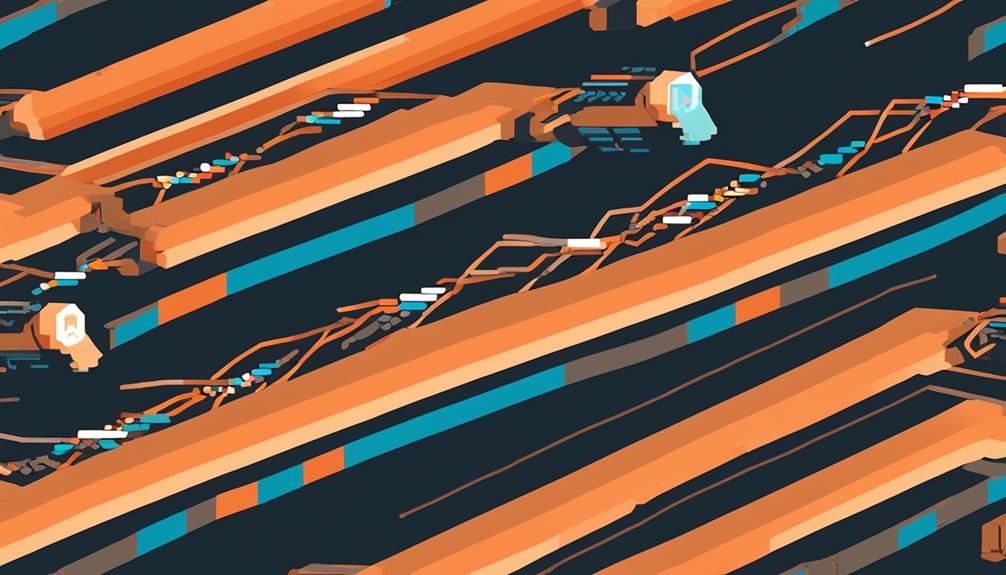
With the growing demand for faster data transfer speeds and reliable communication, the comparison between fiber optic cables and copper cables in telecom becomes crucial in determining the most efficient and effective choice for telecommunications infrastructure. Here are three key points to consider:
- Speed of Light: Fiber optic cables transmit data using light signals, allowing for significantly faster data transfer speeds compared to traditional copper cables. The speed of light in the fiber optic cables enables data to be transmitted over long distances without any loss or degradation in signal quality.
- Electromagnetic Interference (EMI): Fiber optic cables are immune to electromagnetic interference, making them highly reliable for telecommunications. Copper cables, on the other hand, are susceptible to EMI from external electrical fields or noise sources, which can degrade the signal quality and affect communication performance.
- Advantages over Copper Wire: Fiber optic cables offer several advantages over copper wires in telecom. They have minimal loss or attenuation, making them suitable for long-distance installations and large-scale service networks. Additionally, fiber optic cables are more durable and reliable, less susceptible to power outages and external factors, and can provide faster speeds compared to other types of internet connections.
Fiber Optic Cable Infrastructure for Telecommunication Networks
Fiber optic cable infrastructure plays a critical role in establishing efficient and reliable telecommunication networks. These networks, which have largely replaced copper wire in backbone networks, are revolutionizing the telecommunications industry. Fiber optic cables are preferred for their ability to transmit high-speed data over long distances and their immunity to electromagnetic interference. This makes them the ideal choice for data transmission in telecommunication networks.
The infrastructure development for fiber optic systems within cities can be complex and expensive. However, the cost of rolling out fiber to homes has become more cost-effective, leading to increased adoption of fiber optic cables in residential areas. Researchers at Bell Labs have even achieved a record bandwidth-distance product of over 100 petabit × kilometers per second using fiber optic communication.
To provide a deeper understanding of fiber optic cable infrastructure, let's take a look at the following table:
| Aspect | Fiber Optic Cables | Copper Cables |
|---|---|---|
| Bandwidth | High | Limited |
| Data Transfer Speed | Fast | Slow |
| Distance | Long | Short |
As seen from the table, fiber optic cables offer greater bandwidth and faster data transfer speeds compared to traditional copper cables. They can transmit data over long distances without any loss of quality. This makes fiber optic cable infrastructure essential for establishing high-speed and reliable telecommunication networks.
Fiber Optic Cable Capacity and Bandwidth
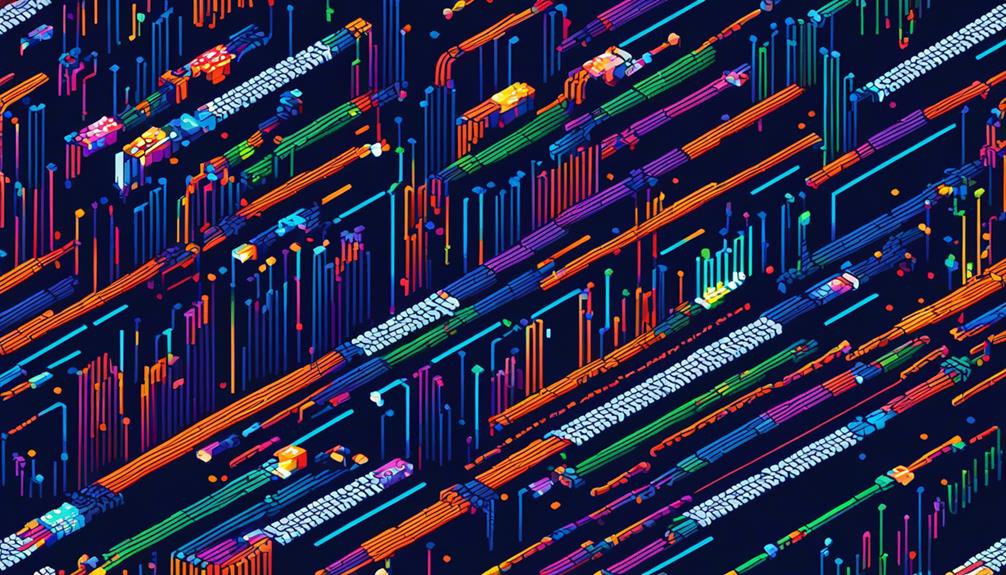
In the realm of telecommunications, fiber optic cables exhibit an unparalleled capacity for data transmission. With their ability to carry signals over long distances and handle huge amounts of data, fiber optic cables have become the backbone of modern communication networks.
Here are three key facts about the capacity and bandwidth of fiber optic cables:
- Higher Bandwidth: Fiber optic cables have revolutionized the telecommunications industry by providing higher bandwidth compared to traditional copper wires. This means they can transmit more data at faster speeds, making them ideal for transmitting information such as voice, video, and data over long distances.
- Single Mode and Multimode: Fiber optic cables come in two main types: single mode and multimode. Single-mode fibers have a smaller core made of glass and are used for longer distances, while multimode fibers have a larger core and are used for shorter distances. Both types can transmit light signals with high efficiency, allowing for reliable internet connections and high bandwidth.
- Lower Signal Degradation: One of the main benefits of fiber optic cables is their ability to transmit signals without degradation over longer distances. Unlike copper wires, fiber cables use light to transmit data, which is not affected by electromagnetic interference. This makes fiber optic cables more reliable and ensures that the full capacity of the cables is used to transmit data.
Factors Affecting Fiber Optic Cable Performance in Telecom
The performance of fiber optic cables in telecommunications is influenced by various factors, including temperature, bending, stretching, vibration, and environmental conditions. These factors can cause signal attenuation and loss, impacting the speeds at which data can be transmitted.
Fiber optic cables work by transmitting data through a light beam that travels along strands of glass. However, when the cables are subjected to extreme temperatures, the glass can expand or contract, leading to a loss of intensity in the light beam and a decrease in internet speeds.
Bending and stretching of fiber optic cables can also affect their performance. When a cable is bent beyond its recommended radius, the light beam can scatter, resulting in signal loss or distortion. Similarly, stretching the cable can cause microcracks in the glass strands, which can further degrade the signal quality.
Vibration is another factor that can impact fiber optic cable performance. Mechanical vibrations, such as those caused by heavy machinery or nearby construction, can introduce signal disruptions and cause signal loss.
Environmental conditions also play a significant role in fiber optic cable performance. Moisture, dust, and exposure to chemicals can degrade the cables over time, leading to signal loss and reduced speeds. It is essential to protect the cables from these elements and regularly inspect and clean them to maintain optimal performance.
Furthermore, the design and quality of the fiber optic cables themselves directly impact performance. The type of glass, cladding, and coating used in the cables can affect signal transmission and longevity. It is crucial to use high-quality materials to ensure reliable and efficient data transmission.
Fiber Optic Cable Standards and Regulations

Are there specific standards and regulations governing the use of fiber optic cables in telecommunications?
Yes, there are specific standards and regulations that govern the use of fiber optic cables in telecommunications. These standards ensure the quality and performance of optical communication systems. International standards organizations such as the International Electrotechnical Commission (IEC) and the Telecommunications Industry Association (TIA) play a crucial role in establishing and maintaining these standards.
Here are three key aspects covered by fiber optic cable standards and regulations:
- Cable construction: Standards define the physical and mechanical properties of fiber optic cables, including the materials used, cable dimensions, and protective coatings. These specifications ensure the durability and reliability of the cables in various environmental conditions.
- Performance specifications: Fiber optic cable standards specify the performance parameters that cables must meet, such as attenuation (signal loss), bandwidth, and dispersion. These specifications ensure that the cables can support high-speed communications and maintain signal integrity over long distances.
- Installation and testing requirements: Standards provide guidelines for the proper installation and testing of fiber optic cables. This includes recommendations for cable routing, connectors, and splicing techniques. Testing requirements help verify the quality of the installed cables and ensure compliance with the standards.
Adherence to these standards and regulations is essential for ensuring interoperability, reliability, and safety in fiber optic communication networks. With their higher speeds and larger core, fiber optic cables have largely replaced traditional technologies like DSL in modern telecommunications. The meticulous standards and regulations that engineers create guarantee the performance and longevity of these critical communications fibers.
Frequently Asked Questions
What Are the Uses of Fibre Optics in Telecommunication Industry?
Fiber optics plays a crucial role in the telecommunication industry. It offers advantages such as high-speed, reliable, and long-distance transmission of data.
With its vast bandwidth capacity, fiber optics enables efficient internet connectivity and seamless data transmission.
Its ability to transmit signals over long distances without signal degradation makes it an ideal choice for intercity and transcontinental networks.
Moreover, fiber optics ensures enhanced security and immunity to electromagnetic interference, making it a preferred choice for various industries apart from telecommunications.
What Are the 3 Types of Fiber Optic Cable?
There are three types of fiber optic cables: single mode, multimode, and plastic optical fiber (POF).
Single mode fiber optic cables have a small core and are used for long-distance, high-bandwidth applications.
Multimode fiber optic cables have a larger core and are suitable for shorter distances and lower bandwidth applications.
Plastic optical fiber (POF) has a large core and is primarily used for consumer electronics, automotive applications, and home networking.
Each type offers distinct advantages and is selected based on specific application requirements.
What Are Fibre Optic Cables Used For?
Fiber optic cables are extensively used in various industries, including telecommunications. They offer numerous benefits, such as high-speed data transmission, revolutionizing telecommunication networks.
Fiber optics play a crucial role in providing internet connectivity, enabling faster and more reliable connections. They are also used in telecommunications infrastructure, providing advantages over traditional copper cables, such as higher bandwidth and immunity to electromagnetic interference.
The future of fiber optic technology in the telecom industry looks promising, with continuous advancements and improved performance.
What Do Fiber Cables Use to Communicate?
Fiber cables utilize advanced communication technology to transmit data through the use of optical signals. These cables are capable of high-speed data transmission, making them ideal for long-distance communication and internet connectivity.
With their high bandwidth capacity, fiber optic cables play a crucial role in supporting network infrastructure. They are widely used in various sectors such as telecommunications, broadcasting, medical scanning, and military equipment, enabling efficient and reliable data transmission across different applications.
